Distance and Direction: Definition, Reasoning Questions, Examples
Distance and Direction Sense in reasoning is a combination of two concepts called distance and direction, where direction defines the movement of an object in a particular direction, and distance is the calculation or measurement of a thing or object with reference to the thing or reference point. While calculating distance, an aspirant has to calculate the total distance or the shortest distance. Total distance is the distance between two points, but the shortest distance can be defined as the displacement between two points. This logical reasoning topic is generally asked in many government exams like Banking, SSC, Railways, CAT, MAH MBA CET, NABARD, State PCS, LIC, UPSC, CMAT, VITEEE, University exams, etc. As the MAH MBA CET is approaching, students can attempt the latest Free Mock Test designed for the aspirants by our experts to score a high percentile in the exam.
CAT 2024: 20 Free Mock Test | 10 Year PYQs | 60 Day Study Material | Most Scoring Concepts
XAT 2025: Section-wise Preparation Tips | Sample Paper
Don't Miss: IBSAT 2024 Mock Tests | NMAT 2024 Sample Papers | MAT 2024 Sample Papers
Question with Solutions: Missing Number | Alphabet Test | Arithmatical Problems | Calendar
- Introduction to Distance and Direction
- Types of Distance and Direction Reasoning Questions
- Top Tips to Solve Distance and Direction-Based Questions
- Question Weightage of Distance and Direction Reasoning Questions in Competitive Exams
- Solved Examples of Distance and Directions
- Distance and Directions Questions for SRMJEE/ VITEEE
- Distance and Directions Questions for TANCET/ JIPMAT
- Distance and Directions Questions for CUET/ Bank Pre/ Insurance Pre exams
- Distance and Directions Questions for SSC/ RRB exams
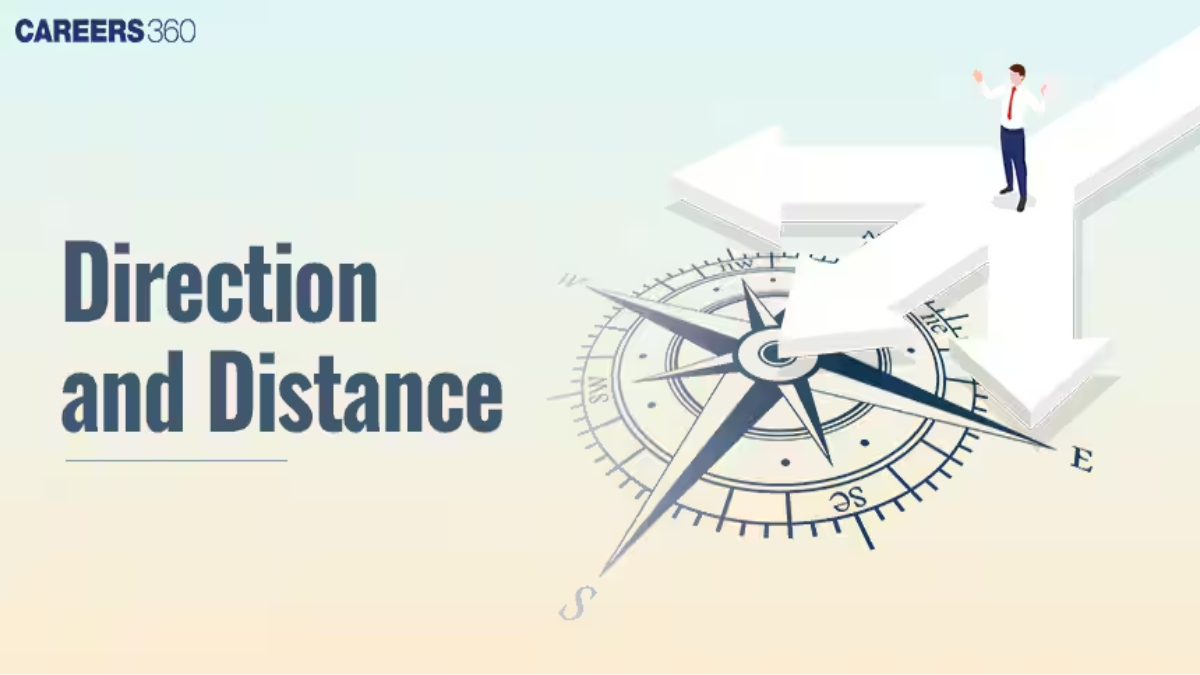
Introduction to Distance and Direction
In this chapter, the terms distance and direction can be defined as -
1) Direction
Direction defines the movement of an object or person in a particular direction.
There are four main directions:
East, West, North and West
Four sub-directions:
North-East, South-East, South-West, North-West
2) Distance
Distance is the measurement of the movement of a person or object from a starting point to a specific point.
Example:
Directions: Ratan walks 15 m towards the north and then turns right and walks 23 m. Then, he turns left and walks 16 m. After that, he turns left and walks 11 m. Then, he turns right and walks 17 m. Then, he turns left and walks 12 m. He finally turns right and walks 19 m. In which direction and how far is he now with reference to the starting point?
1) South, 51 m
2) North, 52 m
3) North, 48 m
4) North, 67 m
Solution:
Firstly, we will draw the diagram as per the given instructions –

From the above diagram, it is clear that Ratan is in the North direction from his starting point.
Ratan's distance between the starting point and the endpoint = 15 + 16 + 17 + 19 = 67 m
Thus, Ratan is towards the North direction and 67 m away from the starting point. Hence, the fourth option is correct.
Types of Distance and Direction Reasoning Questions
Passage Based
Angle Based
Shadow Based
Let’s understand each type in detail -
1) Passage-Based Distance and Direction Reasoning Questions
In this type of question, information is given in passage form. In such passages, the movement of a particular person is given from the starting point to the ending point or vice versa.
Example:
Directions: Kartik walks 40 m straight from his home towards the North. Then, he turns left and walks 25 m. He turns left again and walks 15 m. Finally, he turns left and walks 25 m to reach Point X. What is the shortest distance between his home and Point X?
1) 22 m
2) 25 m
3) 15 m
4) 55 m
Solution
Firstly, we will draw the diagram as per the given instructions –
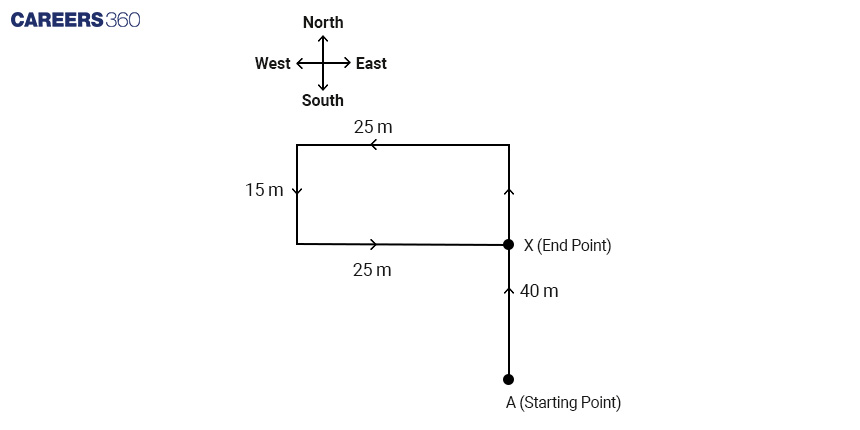
Point A is the starting point and X is the endpoint, so the distance between them is XA.
XA = 40 – 15 = 25
So, the shortest distance between Kartik's home and point X is 25 m. Hence, the second option is correct.
Example:
Directions: Bismita walks 200 m towards the East and then turns right and walks 210 m to reach a hospital. What is the shortest distance between the starting point and the hospital?
1) 310 m
2) 290 m
3) 220 m
4) 260 m
Solution -
Firstly, we will draw the diagram as per the given instructions –

Here, A is the starting point and B is the endpoint.
For the shortest distance (AB) between the starting point and the endpoint,
With the help of Pythagoras' formula -
Hypotenuse2 = Base2 + Perpendicular2,
⇒ (AC)2 + (BC)2 = (AB)2
⇒ (200)2 + (210)2 = (AB)2
⇒ 40000 + 44100 = (AB)2
⇒ (AB)2 = 84100
⇒ AB = 290 m
So, the shortest distance between Bismita's starting point and the hospital is 290 m. Hence, the second option is correct.
2) Angle-Based Distance and Direction Reasoning Questions
In this type of question, the information is given in the angle form, like one has turned 90͒ / 45͒ and so on. Let’s understand this with an example -
Example:
Directions: A girl is standing facing towards the east. She turns 45 degrees in the anticlockwise direction and then turns 180 degrees in the clockwise direction. Which direction is she facing now?
1) West
2) South
3) North
4) South-West
Solution -
As per the given information, the direction the girl will look is as follows –
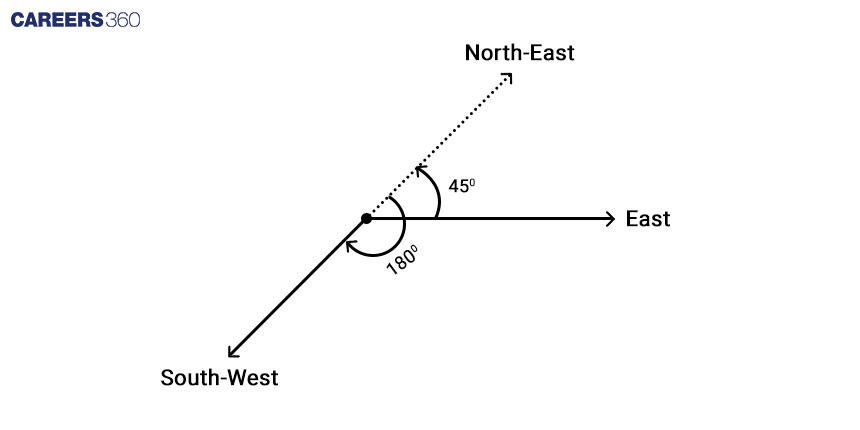
Therefore, the girl is facing towards the southwest direction. Hence, the fourth option is correct.
3) Shadow-Based Distance and Direction Reasoning Questions
In this type of question, the direction of the shadow of a person is asked. To solve this type of question, the understanding of the direction of the sun in the morning and the evening plays an important role. Shadows always fall on the opposite side of the Sun. The shadow falls in the west direction in the morning as the sun rises in the east. Similarly, in the evening, the shadows fall in the east direction, but at 12 PM no shadow will be formed.
Example:
Directions: At the time of sunrise, Diksha and Arpita are sitting in a park with their backs facing each other. If the shadow of Diksha falls to the right of Arpita, then in which direction is Arpita facing?
1) North
2) East
3) West
4) South
Solution
Given: At the time of sunrise, Diksha and Arpita are sitting in a park with their backs facing each other.
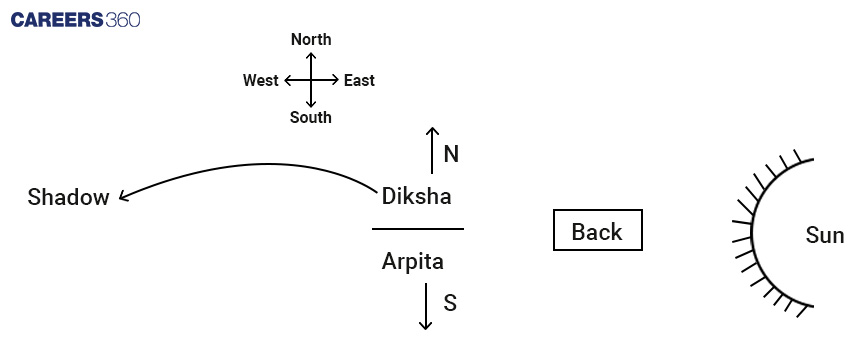
At the time of Sunrise, the Sun is in the east direction, and the shadow will be in the west direction. So, it is given that the shadow is on the right side of Arpita. Therefore, Arpita will face towards the South direction.
Hence, the fourth option is correct.
Top Tips to Solve Distance and Direction-Based Questions
The aspirants must follow the tips given below to solve the distance and direction reasoning questions.
Tip 1: To solve the distance and direction questions, the aspirants must understand the directions. There are four main directions and four sub-directions. The main directions are North, South, East, and West, whereas the sub-directions are North-East, North-West, South-East, and South-West.
Tip 2: After that, the aspirants must know about the right turn and left turn, which is generally asked in the distance and direction reasoning section. The aspirants must check the right and left sides with the position of their hands. It is the easiest method to learn about the left or the right side, or they must remember that the direction of the right turn is always clockwise, whereas the direction of the left turn is always anticlockwise.
Tip 3: The aspirant must learn the Pythagorean theorem to find out the shortest distance between the starting point to the final point.
Tip 4: The aspirants should always apply NESW in a clockwise direction if the clockwise or anticlockwise direction is not mentioned in the question. The North is opposite to the South and the East is opposite to the West.
Question Weightage of Distance and Direction Reasoning Questions in Competitive Exams
The number of questions based on the alphabet test varies from exam to exam -
1) Direction and distance questions are asked in SSC exams, i.e. SSC MTS, SSC CGL, SSC CHSL, SSC CPO, Steno-1 to 2 questions.
2) Direction and distance questions asked in the Railways exam, i.e. Group D, NTPC, JE, ALP, etc - 1 to 2 questions.
3) Direction and distance questions asked in Banking exams - 1 to 5 questions. Sometimes questions based on analogy can be seen in UPSC, CAT, CMAT and IB exams as well.
The most important verbal reasoning topics you must read:
Solved Examples of Distance and Directions
According to the different types, the practice questions for direction and distance are as follows -
1. Passage-based distance and direction questions
1. Directions: A person starts from point Z and moves 7 km towards the South. He turns right and moves 5 km, turns right and moves 3 km, then turns right and moves 1 km. He takes a left turn and moves 4 km to reach point X. How much and in which direction does he need to move now to reach point Z?
1) 4 km South
2) 4 km East
3) 4 km West
4) 6 km East
Solution
Firstly, we will draw the diagram as per the given instructions –

Now, we have to find the direction and distance to reach the point Z.
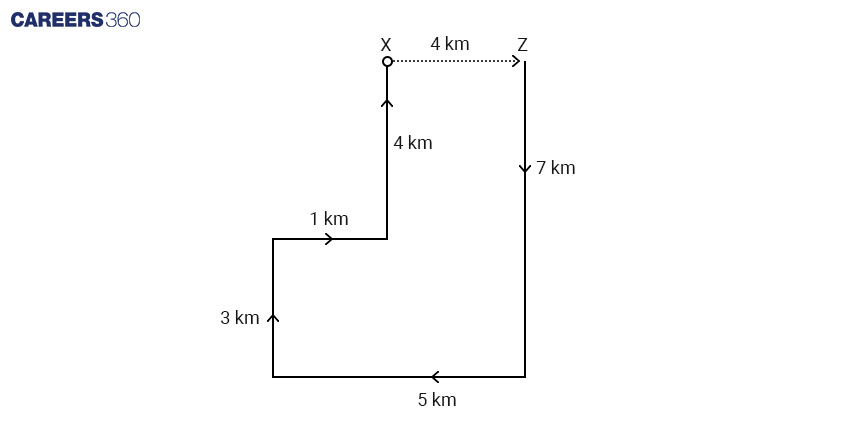
From the above diagram, the Z point is in the east direction and at a distance of (5 – 1) = 4km from point X. Hence, the second option is correct.
2. Directions: A boy walks 15 m north, turns right, and walks 20 m. Again, he turns right and walks 15 m. Finally, he turns to his left and moves 20 m. What is the distance now from his original position?
1) 40 m
2) 46 m
3) 50 m
4) 45 m
Solution
According to the instructions given, the diagram is as follows –
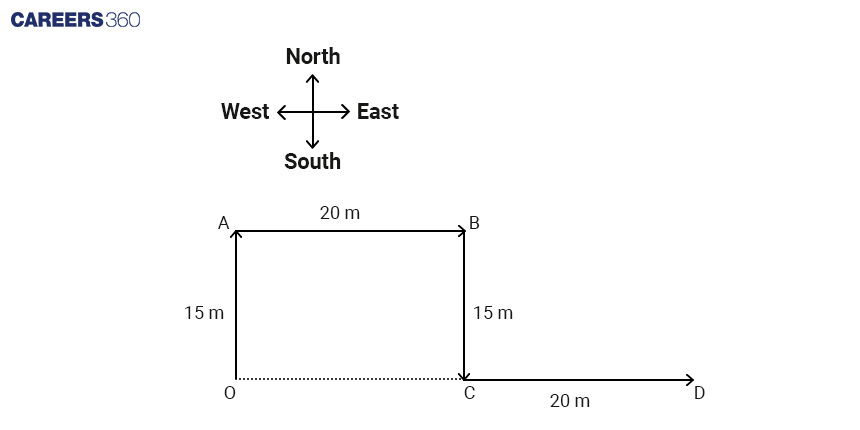
Here, O is the starting point and D is the finishing point, and OD is the total distance from the starting point.
OA = 15m; AB = 20m; BC = 15m; CD = 20m
And, OD = 20 + 20 = 40m
So, the distance now from his original position is 40m. Hence, the first option is correct.
3. Directions: Manoj starts from point A and drives X km towards the south and then turns left and drives Y km. He then takes a right turn and drives for 4 km to reach point D. If Manoj drove a total of 17 km between Points A and D, and both X and Y are perfect squares where X > Y, then what is the value of X?
1) 4 km
2) 11 km
3) 5 km
4) 9 km
Solution:
According to the instructions given, the diagram is as follows –

Now, we have to find the values of X and Y.

Here, A is the starting point and D is the finishing point.
AB = X km; BC = Y km; CD = 4 km
And, the total distance between Points A and D is 17 km.
⇒ AD = AB + BC + CD
⇒ 17 = X + Y + 4
⇒ 17 – 4 = X + Y
⇒ 13 = X + Y
It is given that both X and Y are perfect squares where X > Y, so X = 9 km and Y = 4 km.
So, the value of X is 9 km. Hence, the fourth option is correct.
4. Directions: Starting from point A, an animal walked 15 m towards the East. It took a left turn and walked 25 m. Then, it took a right turn and walked 10 m. Again it took a left turn and walked 15 m. Finally, it took a left turn and walked 25 m. How far and in which direction is the animal now from the starting point A?
1) 25 m, East
2) 40 m, South
3) 40 m, North
4) 25 m, West
Solution:
Firstly, we will draw the diagram as per the given instructions –

From the above diagram, the endpoint is in the north direction from the starting point and at a distance of 40 m. Hence, the fourth option is correct.
5. Directions: Starting from point X, a person walked 20 m towards the South to reach point Y. From there, he took a left turn and walked 25 m to reach point Z. He then took a left turn and walked for another 20 m to reach point P. What is the approximate shortest distance between the points X and Z and in which direction is the person's final position with respect to point X?
1) 50 m, South East
2) 36 m, South East
3) 32 m, East
4) 46 m, North West
Solution:
Firstly, we will draw the diagram as per the given instructions –

Now, we have to find the approximate shortest distance between points X and Z and in which direction is the person's final position with respect to point X.
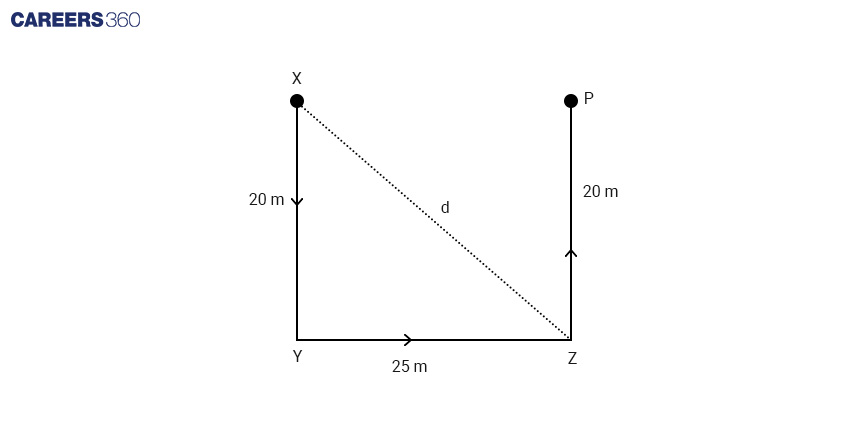
Here, X is the starting point, Z is the endpoint, and the shortest distance between points X and Z = d
Using Pythagoras' theorem, we have
⇒ (d)2 = (20)2 + (25)2
⇒ (d)2 = 400 + 625
⇒ (d)2 = 1025
⇒ d = 32.01 ~ 32
From the above diagram, the endpoint (P) is in the east direction from the starting point (X), and the shortest distance between points X and Z is 32m. Hence, the fourth option is correct.
2. Angle-based distance and direction questions
1. Directions: Joseph starts for his school from his house. He first goes 2 km towards the west and then turns 90° clockwise and goes further 2 km to reach his school. In which direction is his house from his school?
1) Southeast
2) South
3) Northwest
4) North
Solution:
Firstly, we will draw the diagram as per the given instructions –

Now, we have to find the direction of the school with respect to the house.
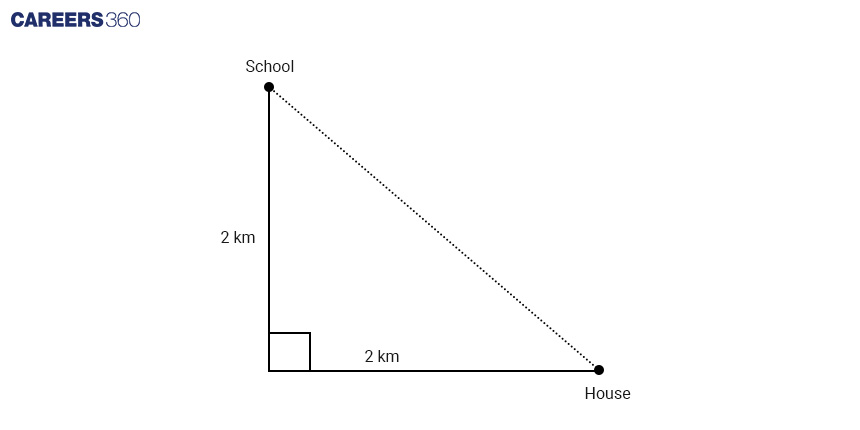
Therefore, the house is in the southeast direction with respect to the school. Hence, the first option is correct.
2. Directions: P started walking from north to south. She turned right at a right angle and then again right at a right angle. In which direction was she ultimately walking?
1) North
2) East
3) South
4) West
Solution:
Firstly, we will draw the direction and distance diagram according to the instructions –

Now, we have to find the direction in which P is moving.
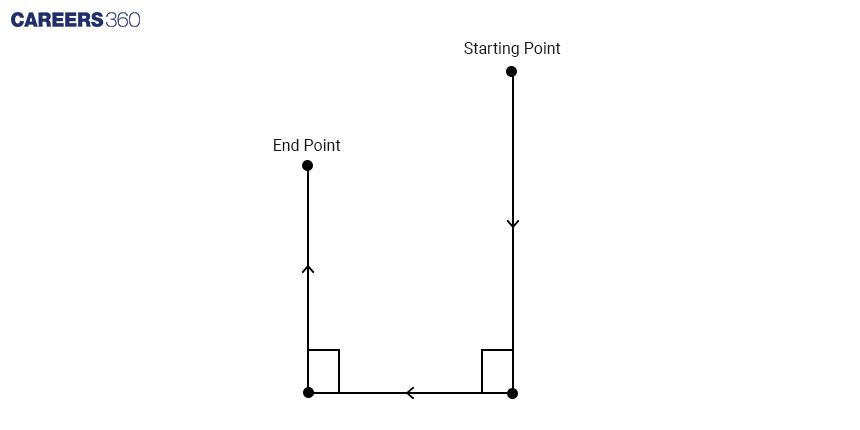
So, P was facing in the north direction. Hence, the first option is correct.
3. Directions: Starting from a point, a person travels 3 km towards the east and turns left and travels 4 km. Then again he turns to the left by 45° and moves straight. Which direction is he facing now?
1) North-East
2) North-West
3)South-East
4)South-West
Solution:
Firstly, we will draw the diagram as per the given instructions –
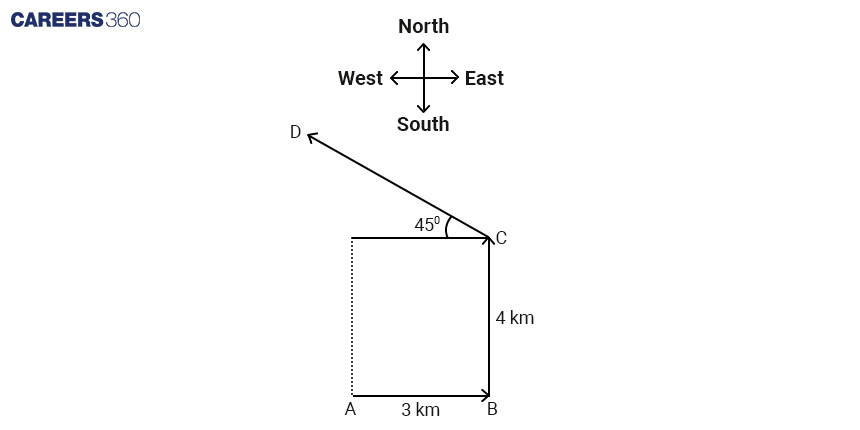
Here, A is the starting point and D is the endpoint.
So, the person is facing in the northwest direction. Hence, the second option is correct.
4. Directions: Vijay walks 10 metres westward, then turns left and walks 10 metres. He then again turns left and walks 10 metres. He takes a 45° turn rightwards and walks straight. In which direction is he walking now?
1) South
2) West
3) South-East
4) South-West
Solution
Firstly, we will draw the diagram as per the given instructions –
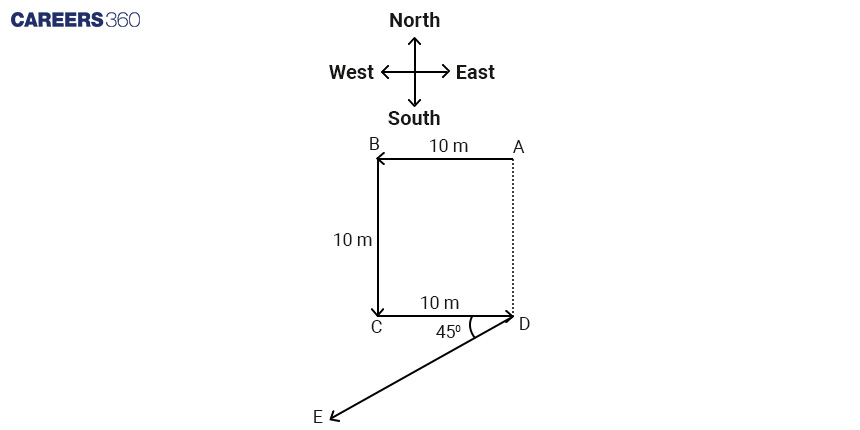
Here, A is the starting point and E is the endpoint.
So, Vijay is walking in the southwest direction. Hence, the fourth option is correct.
5. Directions: Karan, facing south, moved straight 2 km and from there turned to his right 90° and travelled 2 km. Then he took a 45° turn to his left and travelled 1 km. Where would he be now concerning the starting point?
1) South Region
2) South-East Region
3) North-West Region
4) South-West Region
Solution:
Firstly, we will draw the diagram as per the given instructions –

Now we have to find the direction of Karan concerning the starting point.
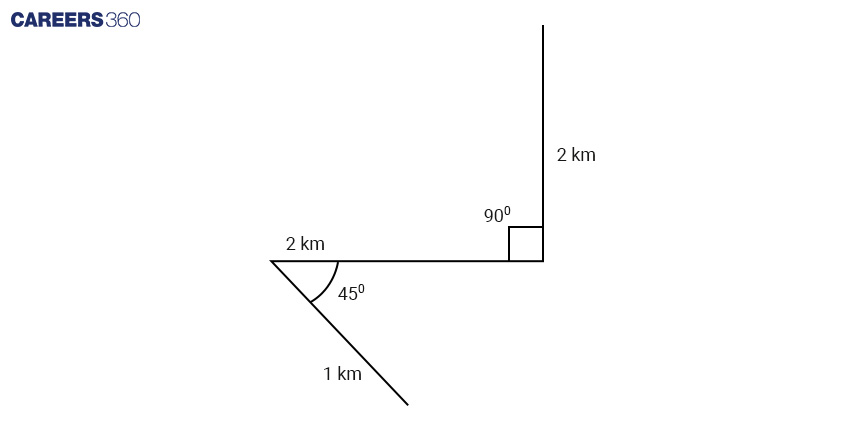
So, Karan is in the South-West region concerning the starting point. Hence, the fourth option is correct.
3. Shadow-Based Distance and Direction Questions
1. Directions: John, in the morning, started walking towards the north and then turned towards the opposite side of the sun. He then turns left again and stops. Which direction is he facing now?
1) North
2) West
3) South
4) East
Solution:
Firstly, we will draw the diagram as per the given instructions –

After walking towards the north direction, John turns toward the left direction (As the sun rises in the east direction and the opposite side of the east is west direction.)
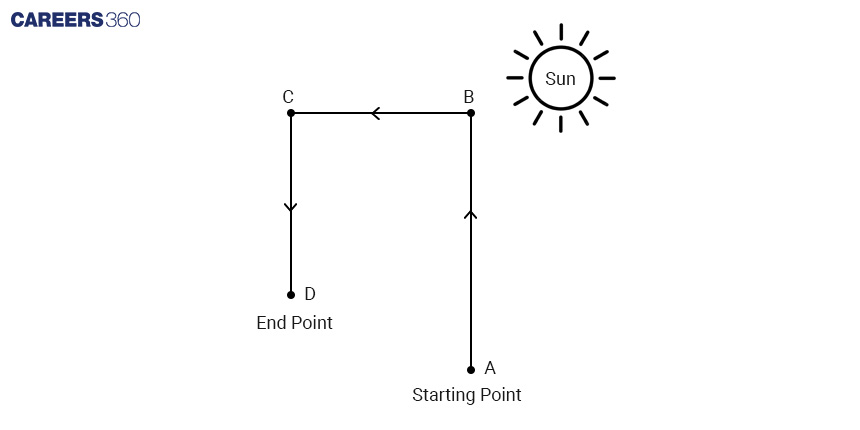
So, John is facing towards the south direction. Hence, the third option is correct.
2. Directions: One morning, Raju walked towards the sun. After some time, he turned left and again to his left. Which direction is he facing?
1) North
2) South
3) East
4) West
Solution:
Given: One morning, Raju walked towards the sun, i.e., he walked towards the east direction. (Because in the morning, the Sun is in the east direction.)
Firstly, we will draw the diagram as per the given instructions –
Now, we have to find which direction Raju is facing.
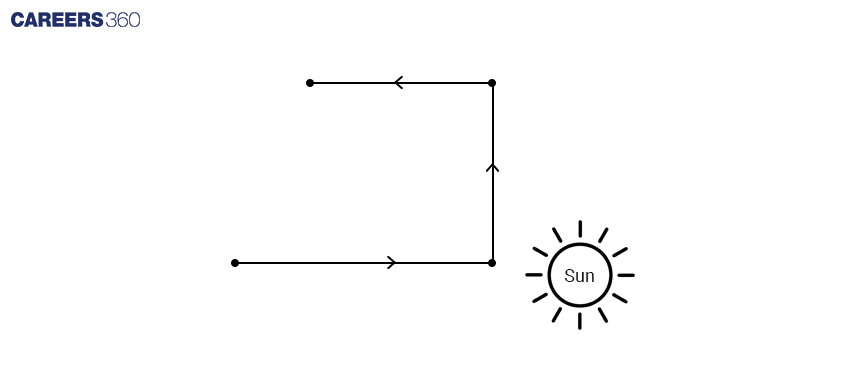
So, Raju is facing towards the west direction. Hence, the fourth option is correct.
3. Directions: Shama, during the time of sunset, started walking towards the opposite side of the sun and then she turned right and right again. What direction is she facing?
1) South
2) West
3) East
4) North
Solution
Firstly, we will draw the direction and distance diagram according to the instructions given in the question

Shama started walking towards the opposite direction of the sun during sunset, i.e., she was walking in the East direction (because during sunset, the sun is in the west direction).

So, Shama is facing the west direction. Hence, the second option is correct.
4. Directions: One morning, Raju walked towards the sun. After some time, he turned left and again to his left. Which direction is he facing?
1) North
2) South
3) East
4) West
Solution:
Given: One morning, Raju walked towards the sun, i.e., he walked towards the east direction. (Because in the morning, the Sun is in the east direction.)
Firstly, we will draw the diagram as per the given instructions –

Now, we have to find which direction Raju is facing.
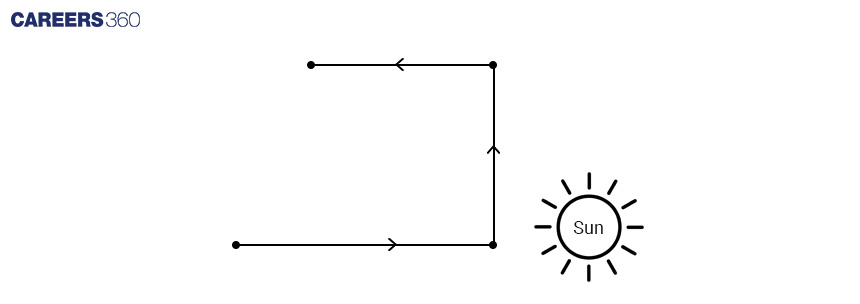
So, Raju is facing towards the west direction. Hence, the fourth option is correct.
5. Directions: John, in the morning, started walking towards the north and then turned towards the opposite side of the sun. He then turns left again and stops. Which direction is he facing now?
1) North
2) West
3) South
4) East
Solution:
Firstly, we will draw the diagram as per the given instructions –

After walking towards the north direction, John turns toward the left direction (As the sun rises in the east direction and the opposite side of the east is the West direction.)
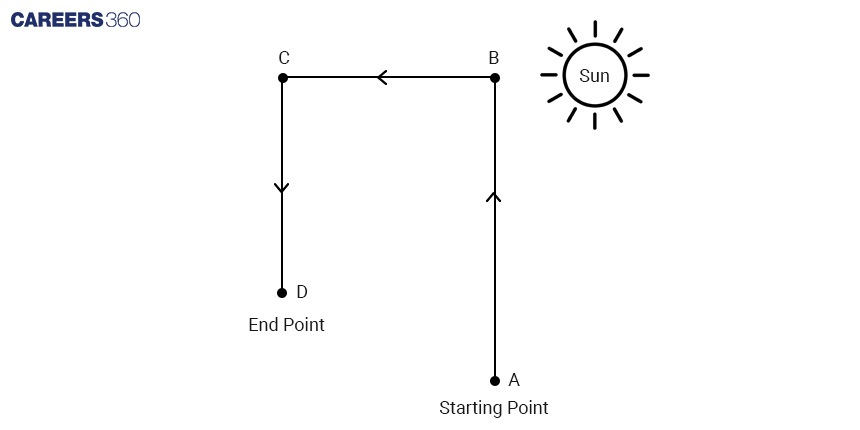
So, John is facing towards the south direction. Hence, the third option is correct.
For more practice, you should attempt the online distance and direction mock test and download the e-book of distance and direction reasoning questions PDF below.
Direction Sense Questions with Solutions PDF
Distance and Directions Questions for SRMJEE/ VITEEE
Q-1) Directions: Kritika walks 40 m towards the south. Then, turning to her right, she rides 30 m. Then, turning to her left, she rides 50 m. Again, she turns to her left and rides 30 m. How far (in m) is she from her initial position?
1) 65 m
2) 70 m
3) 80 m
4) 90 m
Solution:
Firstly, we will draw the diagram as per the given instructions –
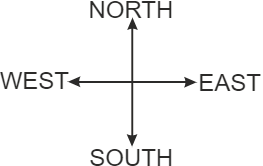
Now, we have to find the distance between the starting and end points –

Therefore, the distance between Kritika's final point and starting point = 40 + 50 = 90 m. Hence, the fourth option is correct.
Q-2) Directions: Kishore starts from a point and walks 6 km towards the east, and turning to his left, he moves 3 km. After this, he again turns to his left and moves 6 km. Now, how far is he from his starting point?
1) 3 km
2) 2 km
3) 4 km
4) 5 km
Solution:
Firstly, we will draw the diagram as per the given instructions –
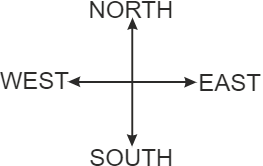
Now, we have to find the distance between the starting and endpoints.
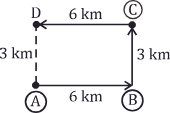
In the figure, A is the starting point and D is the finishing point. So, AD is the distance from the starting point.
Here, AB = CD = 6 km
And, AD = BC = 3 km
So, the distance from the starting point is 3 km. Hence, the first option is correct.
Distance and Directions Questions for TANCET/ JIPMAT
Q-1) Directions: A migrating bird flies 40 km north, then turns east and flies 50 km, then turns north and flies 110 km, and then turns to its left and flies 50 km. Where is it now with reference to its starting position?
1) 150 km south
2) 150 km north
3) 70 km north
4) 70 km south
Solution:
As per the given information, the movement of the bird will look as follows –

The distance between the migrating bird's starting point and end point = 40 + 110 = 150 km
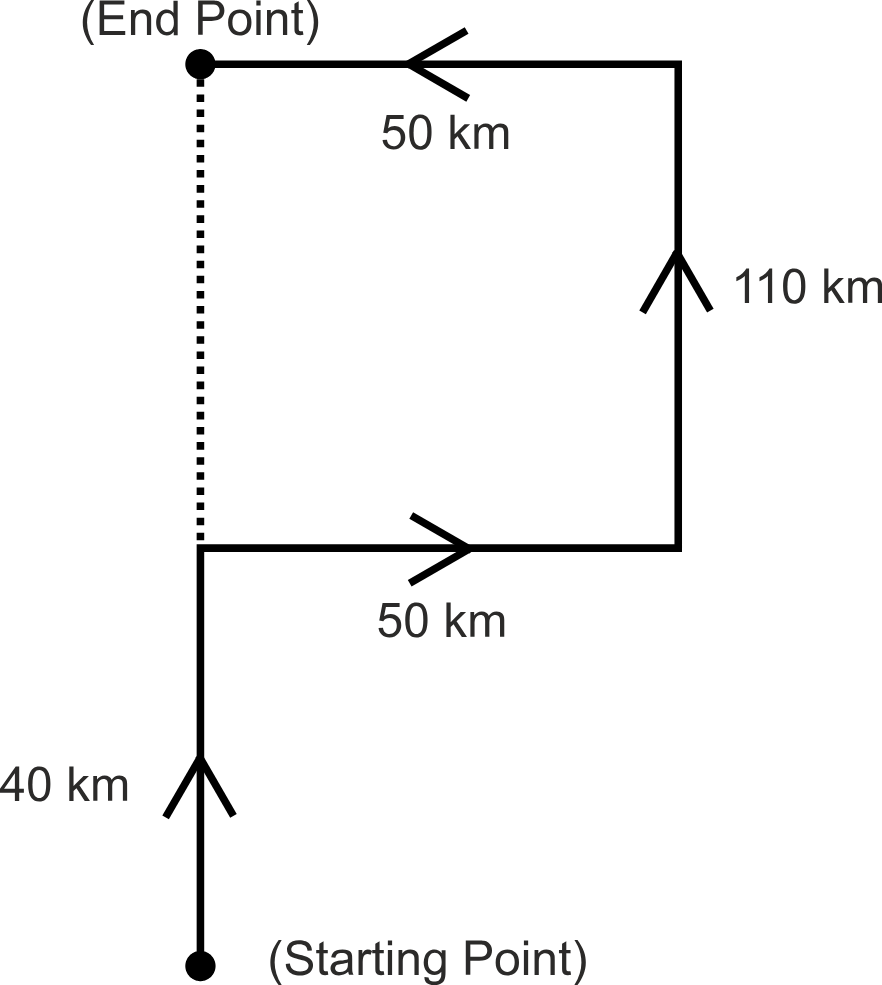
The distance between the migrating bird's starting and end points is 150 km, and the migrating bird is in the north direction with respect to its starting position. Hence, the second option is correct.
Q-2) Directions: A paperboy cycles 10 km east, then turns south and cycles 3 km, then turns west and cycles 6 km, then turns to his right and cycles 3 km. Where is he now with reference to his starting position?
1) 4 km west
2) 14 km east
3) 4 km east
4) 14 km west
Solution:
Firstly, we will draw the diagram as per the given instructions –

Now, we have to find the distance and the final position with respect to the starting position –
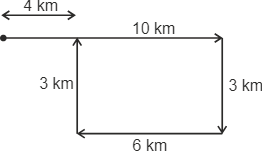
The distance between starting position and end point = 10 – 6 = 4 km
Therefore, the paperboy is in the East direction with respect to his starting position and the distance between his starting point and final point is 4 km. Hence, the third option is correct.
Distance and Directions Questions for CUET/ Bank Pre/ Insurance Pre exams
Q-1) Directions: A man starts from a point, walks 5 km towards the east, turns right and walks 3 km, turns right again and walks. What is the direction he is facing?
1) North
2) South
3) West
4) South-West
Solution
Firstly, we will draw the diagram as per the given instructions –

Here, A is the starting point and D is the endpoint.
So, the man is facing in west direction. Hence, the third option is correct.
Q-2) Directions: If the South-East is changed to North and North-East to West and so on, then what will come in place of South?
1) South-West
2) North-East
3) South-East
4) North-West
Solution
From the given information, South-East means North, and North-East means West.

We can see that, to determine the directions need to move 3rd steps in a clockwise direction.
So, South means northeast direction. Hence, the second option is correct.
Distance and Directions Questions for SSC/ RRB exams
Q-1) Directions: Starting from a point, a person travels 3 km towards the east and turns left and travels 4 km. Then again he turns to the left by 45° and moves straight. Which direction is he facing now?
1) North-East
2) North-West
3) South-East
4) South-West
Solution:
Firstly, we will draw the diagram as per the given instructions –

Here, A is the starting point and D is the endpoint.

So, the person is facing in the northwest direction. Hence, the second option is correct.
Q-2) Directions: Rajneesh started walking towards the north. He took a left turn after walking 20 metres. He again took a right turn after walking 30 metres. Which direction is he facing now?
1) North
2) East
3) West
4) South
Solution:
Firstly, we will draw the diagram as per the given instructions –

Here, A is the starting point and D is the endpoint.
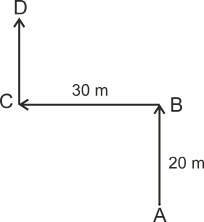
So, Rajneesh is facing in the north direction. Hence, the first option is correct.
For non-verbal reasoning must read the topics below:
About the Faculty
Tanu Gupta, with over a decade of experience as a reasoning faculty, specializes in preparing students for various entrance examinations and career development. Her extensive work with multiple educational platforms and institutions has honed her expertise in logical and analytical thinking. Her dedication to innovative teaching methods ensures these articles provide practical insights and expert guidance.
Frequently Asked Questions (FAQs)
There are some tips and tricks to solve different types of direction and distance-based questions and all the tips and tricks are given above.
Direction and distance questions asked in SSC exams i.e. SSC MTS, SSC CGL, SSC CHSL, SSC CPO, Steno - 1 to 2 questions.In the Defence and Railways exams i.e. Group D, NTPC, JE, ALP etc - 1 to 2 questions. In Banking exams - 1 to 5 questions. Sometimes questions based on analogy can be seen in UPSC and IB exams.
Direction Sense in reasoning is a combination of two concepts called direction and distance where direction defines the movement of an object in a particular direction and distance is the calculation or measurement of the movement of a person, thing or object. While calculating distance an aspirant has to calculate the total distance or shortest distance.
There are some types of direction and distance such as turn and rotation-based, distance and displacement-based, shadow-based, coded, puzzle and angle-based.
The level of the questions of the direction and distance has been seen as easy to moderate in the examinations.
To find distance and direction questions first of all you should be aware of the directions as north, south, east and west. You should solve the distance and direction question by the diagram and after that using the distance and direction formula such as the pythagorean theorem or by simply finding the shortest or longest distance between the given points.